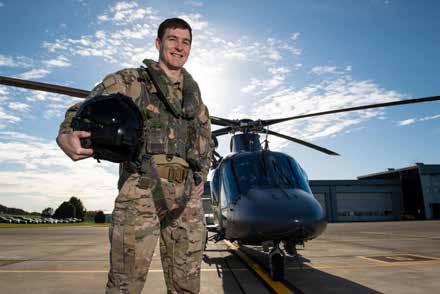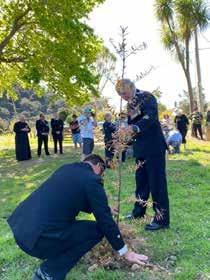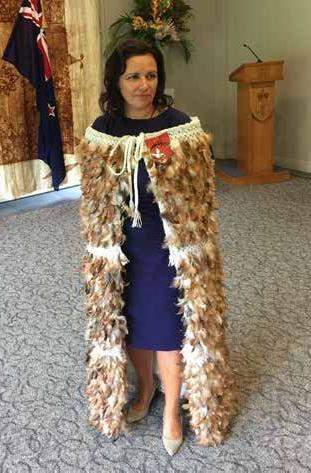
10 minute read
Loadmaster graduation
Former ports worker takes to the sky
As a stevedore at the Ports of Auckland, Michael Fraser dreamed of flying.
Now those dreams have come true after graduating as a Navy Helicopter Loadmaster at RNZAF Base Ohakea last month following 11 months’ training, including flying aboard A109 light utility helicopters. He will now move on to the Seasprite Aircraft Conversion Course and then the Operational Conversion Course. As part of No. 6 Squadron, Ordinary Helicopter Loadmaster Fraser’s role will include winching, photography, load lifting, in-flight refuelling and operating the Mag 58 machine gun. The 25-year-old former Westlake Boys’ High School student can’t wait. “I have always wanted to fly and the Navy gave me the opportunity. The loadmaster role is an exciting one where I will get to help a lot of people and see some amazing sights,” he says. “Being part of the New Zealand Defence Force means that I have a career that I am proud of and that really makes a difference in helping and protecting our country. “Whether it be in border protection, search and rescue or helping after a major catastrophe like the Whakaari/White Island eruption or the Christchurch earthquakes.” Two key moments of his training have stood out so far, he says. “During mountain flying in the South Island we got to see some pretty cool scenery and I enjoyed the night flying phase of training. Looking through night-vision goggles reduces your vision quite a bit so you’re working very hard.” But it’s not all work and no play. As a keen hockey player OHLM Fraser has already represented the Navy in New Zealand Defence Force tournaments and he is extremely happy he can balance his love of sport with his dream career.
“I can make a difference and I love that every day is different, from training to real life situations.
“I have already made some lifelong friends and I am only at the start of my career. If people are thinking about a career that gives them options for travel, sports, further education or just want to make a difference in the world then they should look at all the different opportunities that are in Defence.”

Name change for Hamilton Cadets
The Sea Cadet Unit TS (Training Ship) RANGIRIRI in Hamilton will now be known as TS WAIKATO.
Acting Lieutenant Commander Greg Dyer, the Cadet Unit Commander, says the unit submitted a proposal a year ago for the name change. The unit’s original name is after a 19th century paddle steamer gunboat that was originally built to assist in fighting in Waikato during the New Zealand Land Wars. It saw no action and was modified as a passenger ferry, plying her trade on the Waikato River.
A/CFLTCDR Dyer made the point that there was no discernible connection between RANGIRIRI and the Navy. “The name Rangiriri also refers to a small rural settlement 45 minutes north of Hamilton. This has often created confusion with local residents who believe our unit is situated out of town, thus hampering our ability to attract youth to the unit.” The unit needed a name more representative of the community, iwi and geographic area, he says. “The obvious name was Training Ship WAIKATO. It is a name with which all people of our local environs identify and have a strong sense of connection to.”
HMNZS WAIKATO (F55) was a Leander-class frigate of over 30 years’ service, between 1966 and 1998. In his proposal, A/CFLTCDR Dyer argued that RANGIRIRI represented a military vessel intended for action against Māori during the Land Wars. His cadet membership included Māori and it had to be questioned whether the unit was best represented by the name RANGIRIRI.
“In Hamilton itself the City Council and Kingitanga have signed an accord to review all place names, sites and references of cultural offence with a view to renaming said places in a more culturally sensitive and appropriate way. “While HMNZS WAIKATO has been decommissioned for some years now, her history and service to New Zealand is much more reflective of our modern Navy and the role that the Navy and armed forces in general play on the world stage. The name fits nicely with our New Zealand Cadet Forces mission, vision and values.” It means TS WAIKATO has the most ‘modern’ ship’s name of all 17 sea cadet units. It was relaunched on 11 October with Hamilton City mayor Paula Southgate attending. The ceremony included the retiring of the TS RANGIRIRI life ring and the unveiling of the new TS WAIKATO ring, and the issuing of new cap tallies to the Navy Cadets.

Sea Cadet units are generally named after former Royal New Zealand Navy ships or former Navy ships connected with New Zealand, but there are exceptions. TS TALISMAN in Nelson is named for a local coastal scow. TS GODLEY is named after a pioneer founder of Christchurch. TS NIMROD is named after the ship Shackleton used for an Antarctic expedition. TS AHURIRI, created in September this year, is from the Māori name for Napier.
Coromandel’s Navy links
By Mr Reece Golding, MNZM, MSM, WOSCS (RTD)
In September, personnel from HMNZS NGAPONA sub unit Tauranga, took part in a historic navalrelated community engagement – the commemoration of HMS COROMANDEL’s visit to the ColvilleCoromandel area in 1820.
The purpose of the visit was to harvest kauri logs for the Royal Navy because at the time, England was at war with France and Spain and combat damage was at its greatest. It was the harmonious relationships generated between COROMANDEL’s crew, local Māori iwi and European settlers during the ship’s year-long stay that were the catalyst in the town and peninsula being named after the ship. This year, Colville – Coromandel folk celebrated the event on Saturday 26 September (delayed from Queen's Birthday Weekend because of COVID restrictions) with a formal unveiling of a commemorative sculpture, followed by a range of activities preceding the main event, the Illume Festival. This involved a dynamic street march, with residents and visitors dressed up in costumes to replicate the sailors and loggers from the 1800s. NGAPONA Tauranga’s role was to provide a Flag Party for the formal ceremony which preceded all other events. Local artist Rebekah Pearson was invited to say a few words after the Bicentenary Commemoration Unveiling, and her creation of a symbolic ship in a bottle was stunning. A local sewing group also fashioned an outstanding tapestry of sections of history, which was draped over the sculpture prior to the unveiling and thereafter on show for all to see.
Lieutenant Commander Garth Mathieson, VRD, RNZNVR was guest speaker at the VIP luncheon, and part of a group who visited the Coromandel RSA to present a NGAPONA Crest and raise the New Zealand National Flag at the town’s memorial, accompanied by RSA members, mainly Vietnam veterans. At the end of 1820, COROMANDEL departed New Zealand with 107 kauri logs, to be used as spars as they were strong and straight. A restorative planting of 100 kauri occurred earlier this year at Albert Street Reserve, with NGAPONA personnel planting the remaining seven trees. Archdeacon / Chaplain Michael Berry assisted with officiating at this event. All personnel mustered at Whangarahi Reserves to lower the flags at Sunset, followed by supporting the Coromandel RSA in reading the Ode – for which their members were extremely grateful – before falling in and leading the Illume Festival street march. It was a night of iridescent lights and shapes with shops and local business also participating. The feedback received was extremely encouraging, and in this COVID period where there have been restrictions placed on community engagements, the opportunity to feature Navy in the Coromandel community was very positive for our small sub unit, while also reflecting well on the wider RNZN. Of note is that my contribution as a veteran Warrant Officer in uniform is now complete.


Launch of the Navy Journal
The Royal New Zealand Navy has joined the ranks of Services publishing critical-thinking academic papers with the launch of the Professional Journal of the Royal New Zealand Navy this month.

Dr Lance Beath, a Senior Fellow at the Centre for Strategic Studies, Victoria University, and the RNZN Nelsonian Scholar, is the General Editor of the publication, intended to be biennial. The journal will be a vehicle for publishing Navy staff essays and research papers, naval and maritime articles from guest writers – including Dr Beath and former Chief of Navy Rear Admiral John Martin, and critical book reviews.
Dr Beath, who co-edited the New Zealand Defence Force Maritime Doctrine in 2018, says the Navy was looking for a place to publish the “accumulated wisdom” generated by officers in the course of their post- graduate studies in New Zealand and overseas. “The immediate catalyst, I’m told, was an essay written by an officer while at US Naval War College in the States. The Americans thought it was great stuff, and thought that it should be published.” This idea lodged in the minds of senior Naval leadership, he says. “The Air Force and Army had journals and the Navy didn’t. There was an obvious gap that needed filling. And that’s what’s emerged as the Journal.” He says it’s going to be a good companion publication to the monthly Navy Today. “Navy Today has personal stories, operations, exercises, history. The Journal provides a strategic and policy dimension to New Zealand naval and maritime thinking. It draws on and extends the best thinking available in New Zealand and it will also draw on international thinking in the naval and maritime space.” Examples of “deep thinking” in the first edition include an article discussing the implications for civil and military capability arising from New Zealand’s increasingly
Professional Journal of the
ROYAL NEW ZEALAND NAVY
Te Taua Moana O Aotearoa
Volume One Number One October 2020
contested “maritime periphery”, an article backgrounding the shift in the epicentre of potential conflict from land-based warfare in Europe to maritime conflict in the Asia Pacific, a discussion of what affordability and value means in the defence context and an article that opens up a discussion of defence policy under the heading ‘Towards a New Unifying Military Concept for New Zealand’. The Journal also discusses the Navy’s approach to the current round of strategic reviews and, in a special feature article, it backgrounds a range of important design considerations for the next fleet.
“There are really interesting articles in this journal,” he says. “We are positioning ourselves as active commentators in the maritime and naval strategic policy space. The Journal is an avenue for the writing of officers attending staff colleges, but there are also other topics that will appeal to a wide audience beyond the Navy.”
The RNZN Journal is expected to be out this month. In our next issue and on social media we’ll advise where it can be viewed.
Part 3 Honorary Captains
In our ongoing series in Navy Today on our Honorary Captains, we introduce Shelley Campbell (Ngati Hine), CEO Waikato/ Bay of Plenty Division Cancer Society of New Zealand Inc.
I received my honour in 2015 from Rear Admiral Jack Steer alongside former Waitakere Mayor, Sir Bob Harvey. At the time, I was the Chief Executive of the Sir Peter Blake Trust and I suspect it was a surprise to some, as I didn’t really ‘fit the mould’ of previous Honorary Captains. Perhaps it was about the journey the Navy had embarked on, to reflect our people and country and utilise the leadership talent of all.
At the time I was mentoring young sailors, speaking at RNZN dinners and events and supporting the work of the RNZN Women’s Steering Group. I was Master of Ceremonies at several events and we used to laugh that this was largely because we couldn’t afford to pay an MC and I was free! There have been many highlights working alongside friends and colleagues in the Navy. There were the Young Blake Expeditions to the Kermadec Islands and the Sub Antarctic Islands, and the Youth Enviro leaders forum, which one year included a mock kidnapping at Whangaparāoa training base, making the Seven Sharp News with Mike Hosking. Perhaps I'm most proud of the RNZN leaders stepping up for the NZ dream team as we went into schools to inspire Kiwi kids to dare to dream. My life in the last three years has been very different since I left Auckland. I continue to serve NZ Inc. and my communities in different ways as the Chief Executive of cancer services for over 700,000 people in the middle of the North Island.









